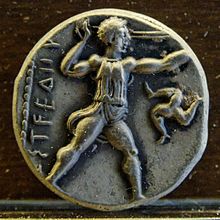Stater
Stater is the name of various coins from ancient times . The stater is considered to be the most important Greek coin. The name means something like the one who weighs and thus points to the earliest function of coins as standardized weights. Therefore, the stater is primarily a normal or unitary piece that defines a unit of weight. In Attic coinage from around 530/20 BC. For example, the tetradrachm forms the stater, which was generally adopted in mints based on the Attic example.
The most widespread stater coins are the gold pieces of Philip II and Alexander the Great of Macedonia, minted according to the Attic foot .
The Greek stater in the ancient coin system
- 1 stater = 2 drachmas
The obolus is the smallest unit, but it has occasionally been split up into further units, up to the eighth obolus ( chalcus ).
See also: Old weights and measures (antiquity)
Well-known stater coins
- The Attic gold stater, mostly in the 5th century BC. Minted, weighs about 8.6 g.
- The ancient Egyptian gold stater , in the 4th century BC. Introduced.
- The Kyziken stater, weighing around 16 g, was a piece embossed from electron (gold-silver alloy).
- The Aeginetic stater is the silver didrachmone weighing 12.3 g.
- The Thai silver stater, about 10 g
- Celtic 1/24 stater
- The darikos was a gold coin minted in the Achaemenid Empire weighing 8.42 g.
See also: Old weights and measures (antiquity)
literature
- Heinrich Chantraine : Stater. In: The Little Pauly (KlP). Volume 5, Stuttgart 1975, Col. 344 f.
